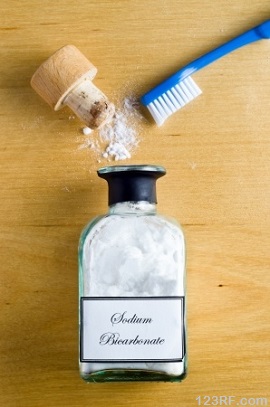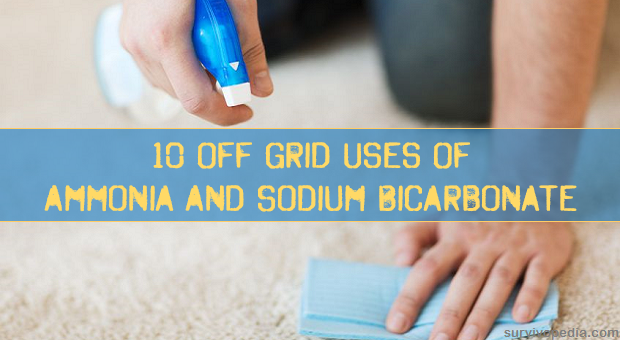As you may be aware, some of the best survival tools and solutions offer multiple use in a single package. Fortunately, there are a number of household items that are inexpensive, plentiful, and capable of serving a dual purpose. For example, if you use ammonia now for some things and baking soda for others, you may already know how useful they are. Here are some additional ways to use these chemicals when living off the grid.
What Is Ammonia?
Ammonia is an alkaline solution commonly excreted in the urine of animals. You should never mix ammonia with bleach, as the two together can form a poisonous gas. That being said, ammonia is very useful as a cleaning agent, fertilizer, and refrigerant. It is an ideal multi-purpose liquid that can form a vital role in long term off grid survival.
What Is Sodium Bicarbonate?
{adinserter emp}Sodium Bicarbonate or baking soda is often used for cooking and medicinal purposes. You can also use it for many other things related to survival needs. It is very important to note that sodium bicarbonate and ammonia are not the same. Confusing the two can be fatal given that ammonia is poisonous.
1. Ammonia for Deterring Moths
Instead of using moth balls or camphor, you can use ammonia to get rid of moths. Simply add 1/2 cup of ammonia to 1 quart of water and spray on drawers, in closets, and any areas where moths might decide to take up residence. Allow each area to air dry before placing clothes or food back in place.
2. Sodium Bicarbonate for Relieving Stomach Acid
Baking soda is one of the oldest and most reliable treatments for heartburn or acid indigestion. Simply add one teaspoon of baking soda to a cup of water and drink it. You can also add a few drops of peppermint oil for additional relief.
3. Ammonia for Stain Removal
Ammonia can be used to remove sweat marks, urine, blood, and non-oily stains from clothes. To remove sweat, blood, and urine, mix 50% ammonia with 50% water and dab on the stain, then wash as normal. For non-oil based stains, rub on stain at 100% concentration and then wash. You can also use ammonia to remove pet and other stains from carpets and upholstery. For these applications, add one cup of ammonia to one gallon of water, dab onto the stain, and let the mixture dry.
4. Sodium Bicarbonate for Cleaning Battery Terminals
In an off grid situation, you are bound to find yourself dealing with acid battery corrosion that prevents you from using perfectly good batteries. To get rid of the acidic corrosion, disconnect the battery. Mix one part water to three parts baking soda and brush onto battery terminals. Wipe off with a damp cloth, and then dry battery terminals before reconnecting to system.
5. Ammonia for Plant Food
Add 1/4 cup of ammonia to a gallon of water for cucumbers and other plants that prefer alkaline soil. When using ammonia to boost soil pH, watch carefully for sudden changes back towards neutral or acidic that might cause more harm to sensitive plants. You can also use ammonia around the garden to deter raccoons and other wild animals that cannot stand its scent.
6. Sodium Bicarbonate for Extinguishing Small Fires
When baking soda is burned, it produces carbon dioxide. To put out a small grease fire, throw baking soda at the base of the flame. If you are cooking on a stove, try to shut off the electricity or gas if possible. In these situations, using baking soda is safer than water because throwing water on an electric fire can cause the current to arc and jump back to you.
7. Ammonia for Refrigeration
Mix ammonia with water and heat up mixture. As ammonia and water cool off, they will recombine and create a lower temperature. Place items to be kept cold in an insulated box with them. This solution will work for about 24 hours before needing to be repeated.
8. Sodium Bicarbonate for Oral Care

9. Ammonia for Removing Soot from Glass
If you are going to use candles or glass lanterns, soot is bound to accumulate on glass walls and chimneys. Simply combine 2 tablespoons of vinegar, and 1 tablespoon of ammonia with 1 quart of warm water. Let the solution sit for a few seconds, and then wipe off. You may need to repeat this procedure two or three times if the stains are set into the glass.
10. Sodium Bicarbonate for Skin Care
If you have rough or dry skin that requires an exfoliant, add 1 part water to 3 parts baking soda. Rub onto skin and then wash off. Baking soda as a body wash is very gentle and can be used daily for smooth, clean, healthy skin.
After a crisis strikes, the first few months are bound to be traumatic as well as a time when you will make all kinds of mistakes. Some familiar chemicals such as baking soda and ammonia can help you achieve a number of goals.
At the very least, if you include some of each chemical in your bug out bag, you will be able to handle a range of situations with fewer problems than expected. As an added bonus, stocking up on these two chemicals will not look suspicious given that they are commonly used in just about every household.
This article has been written by Carmela Tyrell for Survivopedia.









Pingback:10 Off Grid Uses Of Ammonia And Sodium Bicarbonate | Survivalist Basics | Be Prepared For Anything! | November 19, 2014
|
gritch | November 19, 2014
|
How long does household strength ammonia last?
You might also look at higher strength ammonia, available at blueprint supply companies. It must, of course be diluted for the uses you list, but is a lot cheaper and easier to store as a concentrated liquid.
gritch | November 26, 2014
|
It is very important to note that sodium bicarbonate and ammonia are not the same. Confusing the two can be fatal given that ammonia is poisonous.
Is anyone on this forum really that stupid???????????
carmela tyrrell | November 26, 2014
|
Gritch,
Good idea on the concentrated ammonia.
Children can also read these pages; so I wanted to make sure the distinction between the two chemicals is clear. That being said, I have, indeed come across adults (not on this forum) that don’t know the difference between baking soda and ammonia. I also knew of people that mixed bleach and ammonia and wound up dead; so anytime ammonia comes up I am a bit more wary than others; perhaps.
Thx for inquiring though.
Pingback:Common Items To Use For Medical Crisis (II) | The Prepper Dome | May 16, 2015
|
Pingback:Preparing the house – whats done so far | C's renovation journey | June 7, 2015
|
Pingback:3 Recipes For Household And Beauty Products | Survival skills, survival guns, survival guide | August 18, 2015
|
Pingback:6 Ways To Clean Yourself When There’s No Waterdisasterdefense.usdisasterdefense.us | disasterdefense.us | August 21, 2015
|
Marie Boone | November 13, 2015
|
I really appreciate this post! I have never used ammonia as a cleaner and I was not even familiar with what exactly ammonia was, so I am very glad that I have found your article! On the other hand, I use baking soda a lot for many different things – mainly as a cleaner! 🙂
Pingback:Common Items To Use For Medical Crisis (II) | Survivopedia | June 23, 2016
|
Pingback:6 Ways To Clean Yourself When There’s No Water – Prepper Dome | June 23, 2016
|
Mai | October 7, 2016
|
if we need to convert silver bicarbonate to silver carbonate the best method by heating but I want to know if we put ammonia on silver bicarbonate what is the result and if this reaction will produce carbonate?
Pingback:10 Ways To Use Baking Soda For Gardening | Survivopedia | November 5, 2017
|
Pingback:Hygiene When Water Is Missing: Other Ways to Clean Your Body | Survivopedia | November 10, 2017
|